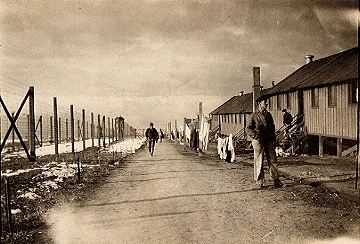World War I: The CO Problem

Ft. Douglas (Utah) C.O. Barracks, Nov. 12, 1919 – Swarthmore College Peace Collection: Eichel Family Papers
The First World War marked the first time that the federal government was forced to deal directly with the issue of religious objection to military service. The government would not allow men to hire a substitute or pay a commutation fee as had been done in the past. As a result, the government looked for ways to deal with those who objected to military service. What happened to conscientious objectors during the years of the American draft of the World War I era came to be widely regarded as a fundamental infringement of civil rights and, in the cases of some objectors who lost their lives, a tragedy.
The earliest problem arose with the wording of the Selective Service Act of 1917. While the act provided for conscientious objectors, it only provided objector status for those who were members of “any well-recognized religious sect … whose existing creed or principles forbid its members to participate in war in any form….” Furthermore, men who objected were not exempt from military service – they still had to serve in the armed forces as a noncombatant. As such, the military held direct authority over COs.
Because the act’s wording regarding a “well-recognized religious sect” proved to be ambiguous, draft boards tended to be arbitrary in classifying men as conscientious objectors. It was a difficult situation faced by the draft boards compounded by the complete lack of information provided by the Selective Service as to what constituted a peace sect. Also making things difficult was the lack of a coordinated effort from the Historic Peace Churches to address the issue. This meant that COs lacked an organization that could lobby on their behalf and voice their desires in a streamlined fashion.
By far the most problematic issue was the lack of alternative service and the absence of a specific definition of noncombatancy. The first response was to place drafted men into the military camps and separate them from the rest of the servicemen. In some cases, the COs were harassed, taunted, and hazed in an attempt to get them to renounce their objection. Some camps were worse than others, but it was a difficult situation everywhere. It was not until March 1918 that President Woodrow Wilson defined noncombatancy as service in the Medical, Quartermaster, or Engineering Corps. A farm furlough plan also emerged concurrently as a rudimentary form of alternative service, but the Peace Churches still saw it as problematic because it fell under military control as well.

Harry Sommers Parole Work Pass, 1918. Sommers was a World War I CO incarcerated at Fort Leavenworth for disobeying orders. - Harry Sommers Papers. HM1-887SC. Mennonite Church USA Archives - Goshen. Goshen, Indiana.
The COs who endured the worst experience were absolutists who rejected any form of military service. Most of the absolutists ended up being sentenced to federal military prisons such as Leavenworth or Alcatraz. Prison guards chained incarcerated COs to the bars or grates in their cells for eight hours a day. One of the cruelest instances of mistreatment occurred when an objector in Alcatraz was transferred to Leavenworth and later died. He had refused to wear a military uniform and was given no other clothing option. In the damp and chilly cell, he contracted pneumonia, received no medical care, and died. For his refusal to compromise his beliefs, the Army sent his body home in a military uniform.
The First World War stood as an example of what not to do with conscientious objectors. As a result, when war clouds loomed during the 1930s, both sides resolved to rectify some of the problems created by hostility, inexperience, and ambiguity that had marked the World War I experience for COs.
< Conscientious Objection The Interwar Peace Church Conferences >